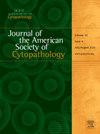荧光原位杂交与细胞学对恶性胆道狭窄准确检测的比较,重点是异常结果。
Q2 Medicine
Journal of the American Society of Cytopathology
Pub Date : 2025-04-11
DOI:10.1016/j.jasc.2025.04.001
引用次数: 0
摘要
胆道刷片细胞学检查是评估胆道狭窄的标准诊断方法,但其敏感性低,不典型诊断率高。荧光原位杂交(FISH)已成为细胞学中越来越有价值的辅助手段。因此,本回顾性质量改进研究的目的是评估传统细胞学和FISH在从胆道刷检样本中正确判断胆道恶性和良性狭窄方面的相对诊断性能,并评估将FISH加入诊断管道是否比单独依赖细胞学提高了诊断准确性。材料和方法:我们对2019年4月至2023年3月期间评估胆道狭窄的患者进行了胆道刷牙和FISH结果的回顾性研究。结果:共检获标本228例。细胞学结果:151例阴性,55例不典型,6例可疑,16例阳性。FISH结果:105例阴性,71例模棱两可,52例阳性。在计算性能指标时,排除细胞学不典型和FISH模棱两可;细胞学可疑被认为是阳性。细胞学检查的敏感性为45.8%,特异性为100%。FISH的敏感性和特异性分别为84.2%和96.0%。结论:我们的研究结果表明,FISH在识别恶性胆道狭窄方面表现出比常规细胞学更高的诊断敏感性。此外,结合细胞学和FISH可能提供更全面的诊断方法,减少假阴性结果的可能性。然而,阳性和模棱两可的FISH结果应仔细解释,并与更具体的细胞学结果一起考虑,以尽量减少假阳性诊断的风险。本文章由计算机程序翻译,如有差异,请以英文原文为准。
Comparison of fluorescence in situ hybridization and cytology for the accurate detection of malignant biliary strictures, with emphasis on unusual results
Introduction
Biliary brushing cytology is the standard diagnostic approach for evaluating biliary strictures, but it has low sensitivity and a high rate of atypical diagnoses. Fluorescence in situ hybridization (FISH) has become an increasingly valuable adjunct to cytology. Therefore, the aim of this retrospective quality improvement study was to evaluate the relative diagnostic performance of traditional cytology and FISH for correctly determining malignant versus benign biliary strictures from biliary brushing samples and to evaluate whether adding FISH to the diagnostic pipeline improves diagnostic accuracy over relying on cytology alone.
Materials and methods
We conducted a retrospective study of biliary brushing and FISH results in patients evaluated for biliary strictures between April 2019 and March 2023.
Results
A total of 228 specimens were retrieved. For cytology results: 151 negative, 55 atypical, 6 suspicious, and 16 positive. For FISH results: 105 negative, 71 equivocal, and 52 positive. When calculating performance measures, cytology atypical and FISH equivocal were excluded; cytology suspicious was considered positive. The sensitivity and specificity of cytology were 45.8% and 100%, respectively. The sensitivity and specificity of FISH were 84.2% and 96.0%, respectively.
Conclusions
Our findings indicate that FISH exhibits considerably higher diagnostic sensitivity than routine cytology in identifying malignant biliary strictures. Furthermore, combining cytology with FISH may provide a more comprehensive diagnostic approach, reducing the likelihood of false-negative results. However, positive and equivocal FISH results should be interpreted carefully and considered alongside more specific cytology findings to minimize the risk of false-positive diagnoses.
求助全文
通过发布文献求助,成功后即可免费获取论文全文。
去求助
来源期刊

Journal of the American Society of Cytopathology
Medicine-Pathology and Forensic Medicine
CiteScore
4.30
自引率
0.00%
发文量
226
审稿时长
40 days
 求助内容:
求助内容: 应助结果提醒方式:
应助结果提醒方式:


